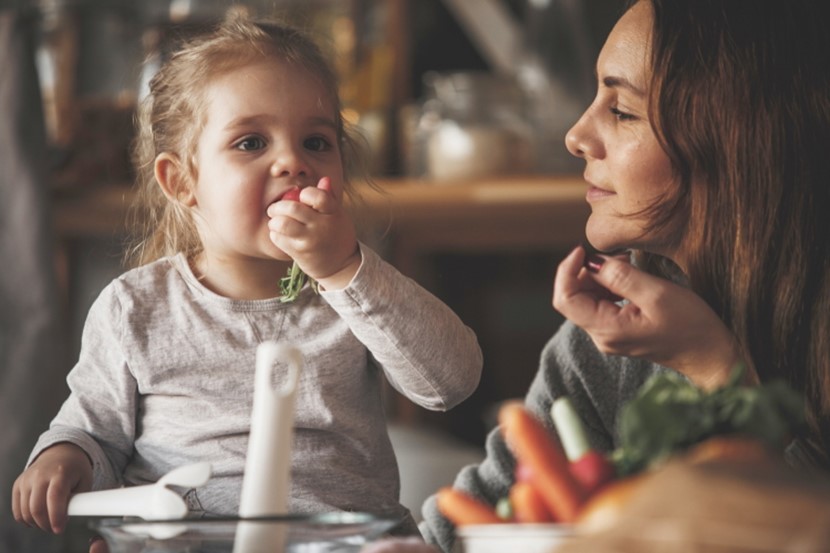More kale please: tips for raising vege loving kids

Dying to hear your kids say ‘more please’ when you serve them fruit and veges? OHbaby! nutritionist Hannah Gentile shares her advice on making fruit and vegetables an attractive food choice.
I recently spent a year in the United States – home of fast lives, fast delivery and fast food. It constantly surprised me what passed as food over there. Forget the free fruit basket at the supermarket – say hello to jumbo sugar cookies instead!
One TV commercial that caught my attention was geared towards parents fed up with the daily negotiation of X number of peas in exchange for ice cream. It opens with a mum chasing her young child around the house, holding out a piece of broccoli she wants the terrified tot to eat. It ends with the family sitting happily at the table while the little girl devours microwave mac ‘n’ cheese. Problem solved ... or is it? I don’t want to pick holes in a happy portrayal of family life, but I’d say most parents wouldn’t really believe that mac ‘n’ cheese is solving the problem. Especially when the problem this parent is actually facing is how to get their child to eat healthily. And eating healthily means having your fruit and vegetables.
A year ago my family embarked upon a mission near-impossible – we were going to eat a plant-based diet. In our case, vegan, because of my husband’s and daughter’s dairy allergy. Now, I will pause here to say it’s a flexible policy. If my kids go to friends’ houses, I won’t insist that no animal products be served. We also have fish once every few weeks. When we fly it’s almost impossible to get a vegan gluten-free meal (argh to the coeliac gene!) so we make do with what is gluten-free.
However, 95% of our home-cooked meals are 100% plant-based. So how do I get my five-year-old and one-year-old to actually consume them? It isn’t always smooth sailing. I’m a nutritionist, not a chef, so there are a few failures. However, I thought I’d share with you some tips from my personal experience, as well as those gleaned from the many families I work with.

START YOUNG
I realise the children of many readers will be beyond this stage, but I want to reinforce the importance of a well-balanced introduction for those ready to start their babies on solids. It’s very important we don’t get stuck in a fearful mindset when introducing solid foods. Babies brought up in vegetarian households don’t starve, and babies in many parts of the world eat spicy curries. It’s all about what we show kids to be the norm.
It’s normal for young babies to screw their faces up when presented with unfamiliar food. We do the same thing when we taste something new. It’s a typical human response. Just keep feeding the food at regular intervals until it becomes a normal taste for your child.
GIVE YOUR KIDS SOME CONTROL
We all like some autonomy in our decisions. Offer your children choices when it comes to mealtime. Would they like potato mashed, baked as oven fries, or steamed? Would they like spinach or mushrooms in their lasagne?
BE FIRM, NOT MEAN
When you make a meal, think of the aspects that your child will like, ie familiar foods that aren’t ‘scary’. These are your child’s ‘safe’ foods – the go-to food that you know they’ll always eat. Then add something new you’d like them to try, or that they used to eat but have started refusing. An example from our household is pasta. I make a yummy vegan sausage pasta with roasted tomato sauce. My daughter was a mushroom queen as a toddler, she’d even happily eat them raw. Then we hit a season where the mushrooms weren’t great quality and she went off them, just like that. However, I know that pasta is her all-time fave, so now I’m much more careful about the quality of the mushrooms I buy, and how I cook them, and I’ll always add them to her pasta. Whether she eats them or not is up to her, but one or two usually make their way in. You can do this with nearly anything: add hummus, avocado or tomato to a cheese toastie, perhaps pop a new vegetable into a fried rice dish, or maybe make a zucchini and banana loaf.
NOT ALL REWARDS ARE EQUAL
If nothing else, I urge you to take heed of this next point. We ALL know food is an easy way to bribe our kids. You need to get the grocery shopping done, so you promise the kids chocolate as a reward. Or you negotiate the consumption of their beans in exchange for a bowl of ice cream after dinner, which turns into one bean, which turns into one bite of one bean, followed by a whole bowl of ice cream. We’ve all been there.
Studies show that rewarding kids for eating one food with another ‘better’ food will just make the original food seem even worse. So what’s the alternative?
Try using time- and play-based rewards, instead of resorting to treat food as a motivational tool. Time-based rewards are activities where you spend quality time together, eg going to the zoo, playing football on the lawn, or making sandcastles at the beach. Play-based rewards are a chance for kids to do something they especially love.
I know it is a very common disciplinary tool, but I strongly encourage parents to resist the temptation to reward behaviour with food. Whether it’s good behaviour, ie “Well done on being brave at kindy, let’s get ice cream”, or undesirable behaviour, ie “We don’t hit in our family, you miss out on dessert tonight”. This just serves to set up an emotional relationship with food and further underpin the idea that some foods are more desirable than others. Again, time- and play-based rewards can really help.
|
MAKE FRUIT & VEGE COOL Another way of making fruit and veges cool is by teaching kids why they’re useful. When writing this article I asked my five-year old, “Why do you eat your vegetables?”. Her response: “So I can be healthy and grow strong like Wonder Woman”. Think of ways to make fruit and veges relevant to your child’s activites. Do they need to eat their rice or fruit so they have the energy to ride their scooter all the way to the park? Will they eat their carrots to help them see well enough to judge where the ball needs to go to score a goal? |
INVOLVE YOUR KIDS IN THE PREP
When a child has a vested interest in healthy food, they’re more likely to eat it. A good example of this is children growing their own veges. Community gardens are useful, but a small planter box at home can also do the trick.
The other option, and one I’ve started doing, is involving our kids in the cooking process. Allow your little ones to help with ingredient choice, stirring, pouring and tasting. As they get older, kids can help chop, measure, and even take the lead on the recipe.
ADD SPINACH TO SMOOTHIES (AT YOUR OWN RISK)
I’m not completely averse to hiding vegetables in other foods – it’s a great way to get nutrients into kids (and adults!) while you wait for their taste buds to mature. A lot of parents successfully keep spinach a secret for years, but hiding food does come with a few risks that I feel compelled to address.
Children can go through a ‘this food is contaminated’ phase. Basically, if ‘safe’ food touches undesirable food, the safe food is now off limits. This may happen for just one meal, or it could strike the once-enjoyed safe food off the list entirely. Hiding ‘unsafe’ food can thus erode your child’s trust, and also banish a nutritious food from their diet.
Secondly, when you hide food you also hide the taste. This might be okay in the short term but it can prolong fussy eating, as children won’t have experienced that food’s actual taste and texture. Kids need to recognise vegetables in ‘real life’ to feel safe eating them.
Thirdly, many of the foods we hide veges in are sweet and this does two things:
☙ It increases our child’s taste preference for sweet over savoury.
☙ It can negatively impact oral health, diabetes, behaviour and energy balance.
Nonetheless, it is a genuine option for transitioning kids into healthier choices and getting more greens in their daily diet. Feeling daunted? Pick one or two of my tips, and give them a go. Remember to keep presenting your kids with healthy options, and eventually you’ll have some wins. And above all, remember meal times are about family and fun!
|
Hannah Gentile is a registered nutritionist and mother of two. She has a black belt in getting her kids to eat a plant-based diet and for that we salute her. She also provides nutritional support and advice for conception, pregnancy, starting solids and fussy eating. Find her at nourishedbynature.co.nz. |

AS FEATURED IN ISSUE 46 OF OHbaby! MAGAZINE. CHECK OUT OTHER ARTICLES IN THIS ISSUE BELOW

















